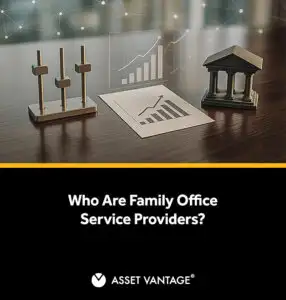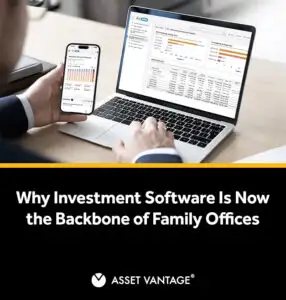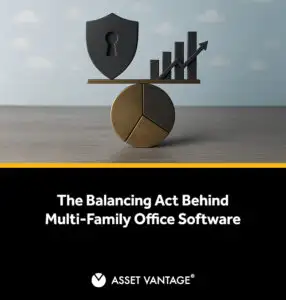Read Time6 Mins

According to Simple’s Family Office Software & Technology Report 2024, 57% of surveyed service providers noted that 80% of family offices still heavily rely on Excel for core financial tasks. Yet behind every formula, there’s an invisible cost: lost time, fragmented insight, and high unproductive hours that lead to outdated and erroneous reports. The real challenge? Spreadsheets weren’t built for the complexity of generational wealth.
What draws them in is its potential for outsized returns and portfolio diversification, especially compared to public markets. Private equity aligns with their long-term mindset—it reflects how they think about wealth: patient, strategic, and growth-oriented. Their ability to keep a track of this is weighed down by lack of standardization and transparency in data across diverse PE holdings causing delayed reporting. With layered and delayed access to current allocations and commitments, they are held back from well informed or timely decision making. What they need is a unified performance reporting and accounting software—purpose-built to match their urgency, precision, and strategic mindset.
The Operational Roadblocks Family Offices Face
1. Data is everywhere—and nowhere unified
Transactions sit in spreadsheets. Capital calls land in emails. Bank balances show up in PDFs. Advisors each send their own reports, formatted differently. The picture is never whole.
2. Every report takes hours, sometimes days
Family office teams spend days reconciling holdings, updating valuations, formatting cash flows, and layering in performance metrics manually.
3. Tax reporting and gain/loss statements are seasonal scrambles
4. Partnership accounting isn’t just hard—it’s fragmented
5. Forecasting liquidity and future cash needs is reactive, not proactive
Without cash flow visibility for each entity, planning for capital calls, debt obligations, personal expenses and potential market opportunities is a nightmare often leading to miscalculated decisions.
Inside AV: How the Platform Actually Works (and Why Spreadsheets Fall Short)
1. Data Aggregation—Automated, Secure, Continuous
Why it matters: Family offices collect data from dozens of sources: brokers, banks, advisors, private investments. With spreadsheets, teams must manually chase down contract notes, email PDFs, and copy-paste data line-by-line—introducing delays and errors.
How AV solves it: AV integrates with 5,000+ custodians, banks, and platforms. Daily feeds pull in transactions, NAVs, corporate actions, and even private equity activity. Data is mapped to the correct asset, entity, and family structure using templates, rules, and identifiers. No copy-paste. No gaps. Just clean, reliable data.
2. Automated Classification and Reconciliation
Why it matters: Spreadsheets require manual tagging of income, expenses, and capital movements. Holdings need to be reconciled separately across multiple entities with data sitting in various tabs or files. This invites inconsistencies and delays audits.
How AV solves it: As data enters the system, AV auto-classifies each transaction—interest income, dividends, fees, capital contributions, distributions. It reconciles these against account balances in real time. Manual journal entries are available but rarely needed. What took hours of checking across worksheets happens instantly in AV.
3. Real-Time Performance and Cash Flow Reporting
Why it matters: Spreadsheets can’t calculate IRRs or model cash flow forecasts without complex formula chains. Even then, insights lag behind live market activity.
How AV solves it: With each data update, AV recalculates IRR, TWR, and performance against benchmarks. Cash inflows and outflows—whether income, expected distributions, or debt obligations—are mapped and forecasted in live dashboards. You can filter by entity, asset class, or advisor, and generate presentation-ready visuals in seconds.
4. In-Built General Ledger Accounting
Why it matters: Spreadsheets need to be exported into accounting software like QuickBooks. This double effort creates inconsistencies and forces finance teams to maintain parallel systems.
How AV solves it: AV, as a fully integrated family office software, includes a built-in general ledger. Each asset, transaction, and adjustment; flows automatically into income statements, balance sheets, capital accounts, and trial balances. For families with multiple entities and shared ownership, this means one system—accounting and investments—tied together by logic.
5. Partnership Accounting That Actually Works
Why it matters: Spreadsheets can’t handle multi-tiered allocations, GP/LP structures, or real-time capital account tracking without risky formula gymnastics. The result: poor transparency, delays, and missed details.
How AV solves it: AV supports look-through accounting across partnerships. It tracks contributions, allocations, distributions, and even waterfall logic—automatically reflected in partner capital accounts. Whether it’s a single trust or a 10-entity structure, every figure is always in sync.
6. Tax-Ready Outputs by Default
Why it matters: At tax time, spreadsheets need to be unpacked, re-sorted, and often rebuilt to prepare gain/loss statements, identify holding periods, and apply indexation. It’s labor-intensive and error-prone.
How AV solves it: AV tracks cost basis, lot-level purchase history, and realized/unrealized gains in real time. Reports can be generated by entity, partner, or asset. Indexation for applicable regions is built in. You get Schedule D-style exports, gain-loss statements, and income reports—all CPA-ready.
7. Document Vault and Audit Trail
Why it matters: In spreadsheets, backup files, capital calls, and scanned contracts live in scattered folders. There’s no clear version history or user accountability.
How AV solves it: Every transaction can be linked to its supporting document—whether it’s a term sheet, KYC file, or valuation report. All user actions are logged. You can see exactly who entered what and when—ideal for compliance and internal controls.
8. Anytime, Anywhere Access
Why it matters: Spreadsheets require emailing files or uploading them to shared drives, with limited mobile usability.
How AV solves it: AV’s mobile app mirrors your web dashboard—entity performance, private equity IRRs, income by advisor, real-time net worth, and cash positions. You can securely review insights or run reports from anywhere, without needing your desktop system.
9. Data Security and Privacy
Why it matters: Family office data includes highly sensitive financial details, private assets, and legal entity structures. Spreadsheets lack built-in protections, access controls, and encryption—leaving exposure risks that traditional IT policies struggle to close.
How AV solves it: AV is built on a private, single-tenant cloud infrastructure hosted on AWS. Every client gets their own isolated environment. Data is encrypted at rest and in transit. Multi-factor authentication, VPN-only access, and user-level permissions ensure only authorized users can view or edit data. All activity is tracked via a full audit log—supporting data governance, compliance, and peace of mind.
Built for the Way Family Offices Actually Work
Each one has moved from reactive operations to structured oversight. With a comprehensive family office software, daily feeds sync before sunrise, portfolios are reconciled before teams log in, and reports are ready before review meetings even begin. From IRRs to entity-level balance sheets, everything runs on one unified engine built for visibility, reliability, and scale.
It’s not just SOC-certified or AWS-encrypted. It’s a living, breathing financial infrastructure that respects the complexity of family wealth—and quietly brings order to it.
It’s not just SOC-certified or AWS-encrypted. It’s a living, breathing financial infrastructure that respects the complexity of family wealth—and quietly brings order to it.







